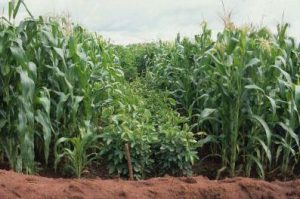Intercropping
Intercropping allows you to use your space efficiently, utilizing multiple layers, and planting optimal crops between rows. These techniques could maximize the yields per area grown. Some strategies include planting deep-rooted crops with shallow-rooted crops, or planting a tall crop with a shorter crop that requires partial shade. Plants that have large structures or leaves, such as corn and squash, can provide a shelter and filtered sun for lower, larger leaved plants such as lettuce. Corn stalks also provide support for vegetable vines. Lettuce can handle the light sun of spring and fall, but requires protection during the heat of summer. When lettuce receives too much heat they tend to bolt (go to seed).
Many narrow leafed plants such as onions, leeks, shallots, and garlic can easily fit between many leafy vegetables. Plants that are prone to tip over in the wind or rain, may be given structural support by their companion crop. Alley cropping involves crops grown in between rows of trees, and strip cropping, where multiple rows of one crop are alternated with multiple rows of another crop.
Another benefit of intercropping strategies include increased insect pest and disease resistance. Repellant intercrops mask the smell of production crops in order to keep pests away from it. Push-pull cropping is a mixture of trap cropping and repellant intercropping. One type of crop attracts the pest and the alternative crop repels the pest away. Monocropping has a tendency to attract similar pests, that are susceptible to similar diseases. Also, if you intercrop with plants from the same family, your soil may experience nutrient depletion since plants within the same family require similar nutrients. The depletion of nutrients will promote troublesome insects and illnesses in your crops.
Intercropping can increase weed suppression based on the use of crop sequences that create varying patterns of resource competition, allelopathic interference, soil disturbance and mechanical damage to provide an unstable and frequently inhospitable environment that prevents the proliferation of a particular weed species. Greater crop yield and less weed growth may be achieved if intercrops are more effective than sole crops in taking resources from weeds. Alternatively, intercrops may provide yield advantages without suppressing weed growth below levels observed in component sole crops if intercrops use resources that are not exploitable by weeds or convert resources to harvestable material more efficiently than sole crops.
